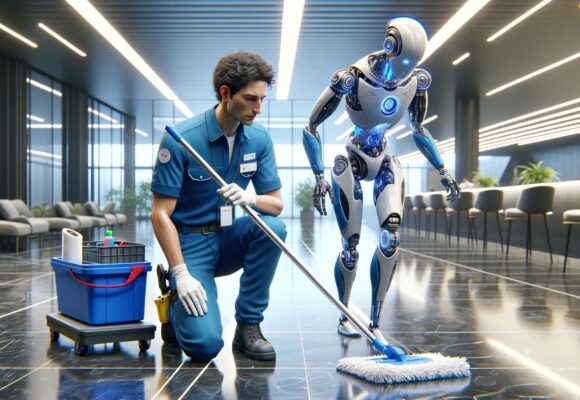The future impact of artificial intelligence (AI) on janitorial and cleaning services globally is poised to be significant, with the potential to transform how cleaning tasks are planned, executed, and managed. As AI continues to evolve, its application within the janitorial sector could lead to increased efficiency, cost savings, and higher standards of cleanliness, among other benefits. However, this technological shift also presents challenges and drawbacks that must be carefully navigated. Here’s a synopsis of the pros and cons:
Pros
1. Increased Efficiency and Productivity
AI can optimize cleaning schedules and routes, ensuring that resources are used more efficiently. For example, AI-powered robots can clean large areas faster than human workers, and AI systems can analyze data from sensors to determine the most needed cleaning areas, reducing wasted effort and focusing on high-traffic zones.
2. Improved Quality of Cleaning
AI technologies can consistently perform at a high standard, with robots and automated systems capable of executing repetitive tasks without fatigue. This can lead to a more consistent and thorough cleaning outcome, potentially reducing the spread of infections in places like hospitals and public buildings.
3. Cost Savings in the Long Term
Although initial investment in AI technologies and robotic cleaning equipment may be high, they can lead to significant cost savings over time. Automated systems can work around the clock without the need for breaks, reducing the labor costs associated with human cleaners and increasing productivity.
4. Enhanced Safety
AI-driven cleaning devices can perform hazardous tasks, such as cleaning at heights or handling toxic substances, reducing the risk of accidents and improving workplace safety for human workers.
5. Data-Driven Insights
AI can provide valuable insights into cleaning needs and efficiencies, allowing for better management of resources and improvements in service delivery. For example, data collected by AI systems can inform managers about the most frequently used areas and those requiring more frequent cleaning, leading to more informed decision-making.
Cons
1. Job Displacement
One of the most significant concerns is the potential displacement of human workers as tasks become automated. This could lead to job losses in the janitorial sector, affecting livelihoods and increasing unemployment rates among lower-skilled workers.
2. High Initial Investment
The cost of implementing AI technologies, including purchasing robots and installing AI systems, can be prohibitively expensive for many small and medium-sized cleaning services. This financial barrier could slow the adoption of AI in the sector.
3. Technical Challenges and Maintenance
AI and robotic systems require ongoing maintenance and technical support to operate effectively. This could present challenges, especially in areas lacking the infrastructure or technical expertise to support these technologies.
4. Lack of Human Touch
While AI can improve efficiency and consistency, it lacks the human touch and adaptability that experienced janitorial staff provide. There are situations where human judgment and flexibility are irreplaceable, such as in handling delicate surfaces or responding to unforeseen cleaning needs.
5. Ethical and Privacy Concerns
The use of AI and surveillance technologies in cleaning operations raises ethical and privacy issues. For instance, sensors and cameras used to optimize cleaning schedules could inadvertently monitor human activity, leading to concerns over surveillance and data privacy.
In summary, the future impact of AI on janitorial and cleaning services holds promising benefits in terms of efficiency, cost savings, and safety. However, it also poses significant challenges, including job displacement, high costs, and ethical concerns. Balancing these pros and cons will be crucial for stakeholders in the cleaning industry to ensure that the adoption of AI technologies leads to positive outcomes for businesses, workers, and clients alike.


 10 Feb 2024
10 Feb 2024
 Posted by Watchdog Ent.
Posted by Watchdog Ent.  0 Comment
0 Comment 









